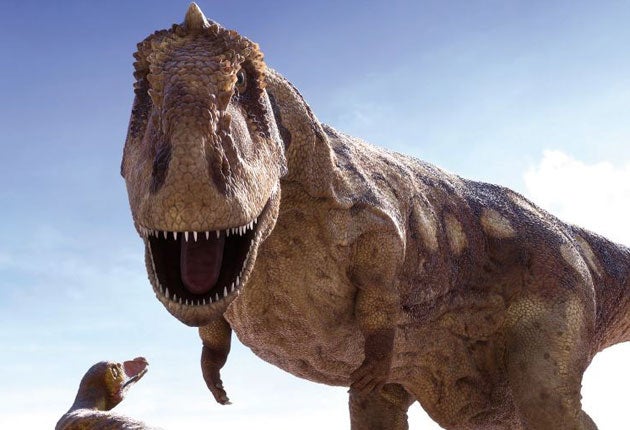How to get the dinosaur look
With only 65m-year-old bones to work with, how have experts managed to create accurate images of long-dead dinosaurs? Olly Bootle explains

Dinosaurs are all around us: in movies, toy shops, museums, and children's books. We all think we know what they looked like. Yet they died out around 65 million years ago, and all we have left of them are some incomplete fossil remains.
So how do we know anything about them? How do scientists put together a dinosaur exhibition that requires working out how these animals looked and moved? Here are eight of the keys steps.
Step 1 Find bones
Dinosaurs may be well-established stars of our planet's history, but if we'd never found any of their bones, we wouldn't have a clue that they'd ever existed. It's impossible to say when the first bones were discovered, but it's likely that dinosaur fossils are the basis for legends about dragons. People had been finding them for centuries, with no idea of what they were. As recently as the 17th century, the thigh bone of a megalosaurus was thought to have belonged to some kind of giant human.
Today, dinosaur fossil finds are common enough that palaeontologists often won't bother fully excavating a discovery unless they suspect the buried bones are of particular interest – either because they might be a new species, a very popular species, or because the fossil remains seem unusually complete or well-preserved.
Step 2 Clean up bones
After spending at least 65 million years buried underground, it's not easy to separate dinosaur bones from the rock that encases them. One single bone can take a couple of months to be cleaned up, so getting an entire skeleton of a large dinosaur ready for an exhibition takes years.
Step 3 Work out the animal that the bones belong to
Palaeontologists will have a good idea of what they're working on while they're at the dig site, based on the approximate size and shape of the bones they're digging up, and also on the age of the rock layer that they're digging in – which will tell them when the animal died.
But once the bones are cleaned up as much as possible, the real academic analysis can begin. At this stage, experts will compare what they've dug up with the more than 500 species of dinosaur that have already been discovered, to see what matches – or to see if they've found a new species. And surprisingly, finding a new species of dinosaur isn't as rare as you might think. With new parts of the world now being explored, scientists are discovering about one new dinosaur every week.
Step 4 Work out how the bones go together
With the wealth of knowledge that we've now amassed about dinosaurs, it can be reasonably straightforward to work out how the bones of a new species fit together – it's likely that any new discovery will be reasonably similar to something we already know about.
But that doesn't mean that mistakes haven't been made in the past. The first ever dinosaur exhibition in the world, in south London's Crystal Palace Park, includes a number of howlers.
One of them is the megalosaurus, which is standing on four legs, whereas in fact it was bipedal, more like a T-rex. The first ever T-rex reconstruction, at the American Museum of Natural History in New York, was also wildly inaccurate. Constructed in 1915, it depicted the animal standing in a very upright pose with its head held high and its tail dragging on the ground, like a kangaroo.
We now know that T-rex's tail jutted out behind it, balancing the enormous weight of its forward-thrusting skull.
Step 5 Work out what a fleshed-out creature would have looked like
Most people who go to a museum want to see more than just a skeleton. They'd rather see a lifelike recreation of the animal, complete with fully fleshed-out muscles and face. But soft tissue very rarely fossilises, so how on earth do scientists work out what muscles an animal that lived millions of years ago might have had?
Clues lie in the bones, which often have "attachment scars". These are marks on the bones which show you where muscles were attached to them, and the size of the scar will give an approximate indication of the size of the muscle that used to attach to it.
Step 6 Add the final layer
Until recently, all dinosaurs were thought to have scaly, reptilian skin. But new discoveries have led to an astonishing revelation. A large number of fossils have recently been discovered in China that show that some species had feathers.
It turns out that even some tyrannosaurs were feathered, which raises the surprising possibility that the most fearsome dinosaur of them all – T-rex – might actually have had fluffy offspring.
Step 7 Colour
Palaeontologists always assumed that we'd never be able to know for sure what colour dinosaurs might have been. But the discovery of feathered dinosaurs has given us an incredible insight into dinosaur colour.
Previously, they've always been portrayed in various reptilian shades of brown, green, and grey. But, amazingly, buried within the fossilised feathers that have been discovered, there are clues about what colour these dinosaurs were in real life - and they're not reptilian at all.
One dinosaur, sinosauropteryx, for example even had an orange and white striped tail.
Olly Bootle is the producer of 'How To Build a Dinosaur', 9pm, Wednesday, BBC4
Join our commenting forum
Join thought-provoking conversations, follow other Independent readers and see their replies
Comments
Bookmark popover
Removed from bookmarks